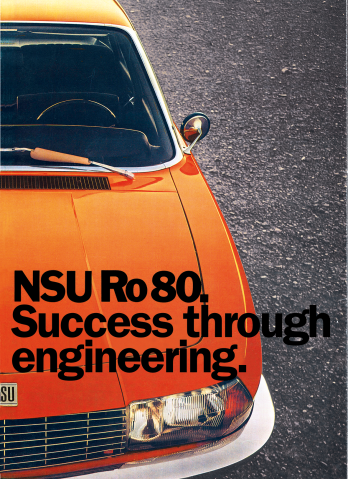

After a number of changes and improvements and above all after a transition to the simpler rotary piston variant with a stationary housing, NSU initially developed a whole range of Wankel engines for a wide variety of applications from water-ski towing equipment to fire engine water spray propulsion, until finally a clear decision was made to concentrate on vehicle engines.
With the NSU Prinz, the company had already presented its first post-war automobile in 1957, which was continuously developed in the following years. In 1964, its sporty version became the basis for the NSU Wankel-Spider - the first car in the world with a rotary piston engine.
This was followed in 1967 by the NSU Ro 80, which was to become the pinnacle of engineering from Neckarsulm - and at the same time the beginning of its end.
For although the Ro 80 was a real technical pioneering achievement, which was perfected over the next 10 years, NSU Motorenwerke AG overreached themselves financially. As a result, it merged with the VW subsidiary Auto Union GmbH in 1969 to form Audi NSU Auto Union AG. The well-known slogan "Vorsprung durch Technik" (Success through engineering), which was developed for the Ro 80 in 1971 and later used for the entire company, also dates from this time.
In 1985, when Audi NSU Auto Union AG was finally renamed Audi AG, the NSU brand disappeared completely from the automotive market. However, it lives on at the stock market - as a symbol for the Audi share. In purely legal terms, Audi AG is nothing more than NSU AG, which has been renamed several times.
When NSU began working with Felix Wankel in the 1950s, the company could already look back on a long history. It all began in 1873 in Riedlingen on the Danube with the founding of the "Mechanical Workshop for the Manufacture of Knitting Machines". In 1880 the company headquarters were moved to Neckarsulm, from 1886 bicycles were also manufactured and from 1892 the trademark "NSU" (as short form of Neckarsulm) was used.
From 1901 the production of motorcycles and from 1906 of automobiles was added. The motorcycle division in particular ensured the company's international importance throughout. In the period after 1945, NSU machines such as Quick, Fox, Lux and Max wrote motorcycle history. In addition, NSU was very successful in motorcycle racing. And so the head of the development and racing department, Dr. Walter Froede, was immediately very interested when he heard about Felix Wankel's promising work on flat and roller rotary vane controls for reciprocating piston engines.
A first visit to Wankel took place on 06.10.1951 and soon there was agreement on a cooperation for rotary vane engines. Subsequently, Wankel repeatedly addressed the subject of "rotary piston machines", but the designs at that time were still too far away from technical feasibility and NSU was not prepared to invest in unexplored new territory.
Only after Wankel's convincing sketch for the 2:3 translated trochoid shape of 13.04.1954, which was further elaborated by Wankel's chief designer, Dipl. Ing. Ernst Höppner, an additional contract for the development of rotary piston machines could finally be signed on 16.09.1954.
